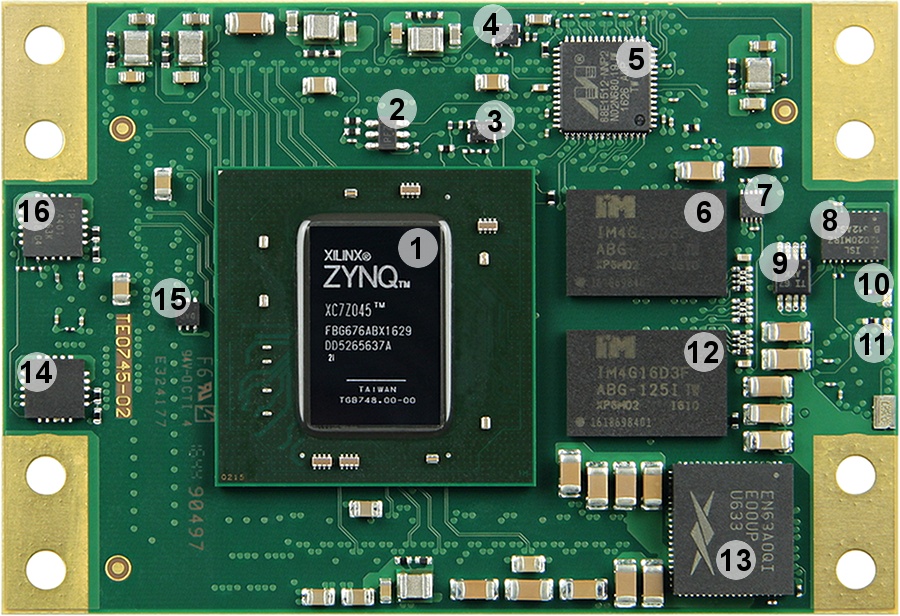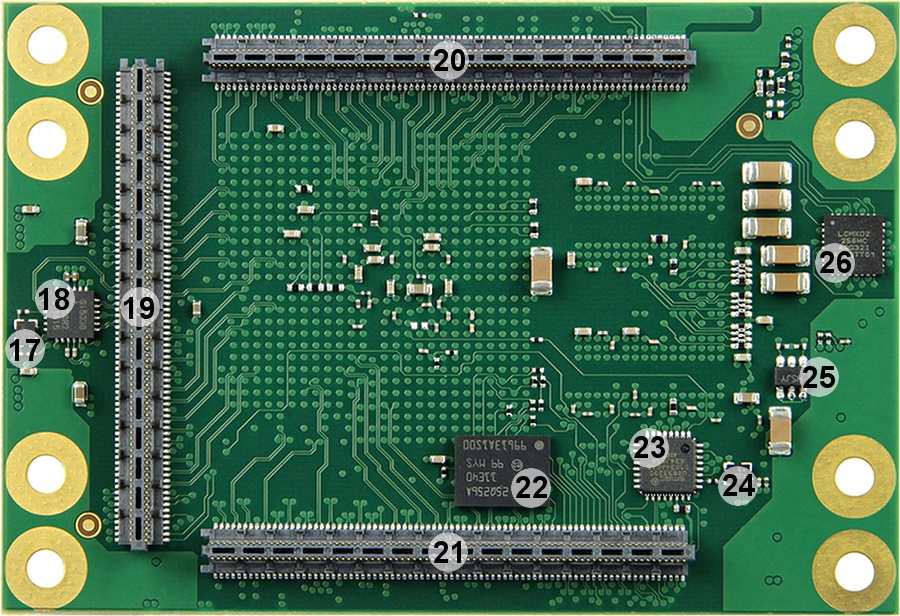Page History
...
| Scroll Only (inline) |
|---|
Refer to https://wiki.trenz-electronic.de/display/PD/TE0745+TRM for online version of this manual and the rest of the available documentation. |
The Trenz Electronic TE0745 is an industrial-grade module integrating a Xilinx Zynq SoC (XC7Z-030, XC7Z-035 or XC7Z-045), 1 GByte DDR3/L SDRAM, 32 MByte SPI Flash memory for configuration and operation and powerful switch-mode power supplies for all on-board voltages. A large number of configurable I/O's is provided via rugged high-speed stacking strips.
...
Figure 1: TE0745-02 Block Diagram.
Main Components
Figure 2: TE0745-02 SoC module.
- Xilinx Zynq XC7Z family SoC, U1
- 256 Mbit Quad SPI Flash memory Micron N25Q256A, U12
- Reference clock signal oscillator SiTime SiT8008BI @33.333333 MHz, U12
- Reference clock signal oscillator SiTime SiT8008BI @25.000000 MHz, U9
- Marvell Alaska 88E1512 Gigabit Ethernet PHY, U3
- Intelligent Memory 512 MByte DDR3L-1600 SDRAM (8 Banks a 32 MWords, 16-bit word width), U3
- TI TPS51206 DDR3 memory termination regulator with buffered reference voltage VTTREF, U18
- Intersil ISL12020MIRZ Real-Time-Clock, U24
- TI TCA9517 level-shifting I2C bus repeater, U17
- Red LED, D2
- Green LED, D1
- Intelligent Memory 512 MByte DDR3L-1600 SDRAM (8 banks a 32 MWords, 16 Bit word width), U5
- Altera Enpirion EN63A0QI 12A DC-DC PowerSoC @1.0V (VCCINT), U4
- TI TPS74401RGW LDO DC-DC regulator @1.2V (MGTAVTT), U8
- TI TPS72018DRVR LDO DC-DC regulator @1.8V (MGTAUX), U6
- TI TPS74401RGW LDO DC-DC regulator @1.0V (MGTAVCC), U11
- Silicon Labs Si5338A I2C Programmable Quad Clock Generator, U13
- Reference clock signal oscillator SiTime SiT8008BI @25.000 MHz, U21
- Samtec ST5-80-1.50-L-D-P-TR 160-pin stacking strips (2 rows a 80 positions), J3
- Samtec ST5-80-1.50-L-D-P-TR 160-pin stacking strips (2 rows a 80 positions), J1
- Samtec ST5-80-1.50-L-D-P-TR 160-pin stacking strips (2 rows a 80 positions), J2
- 256 Mbit Quad SPI Flash memory (Micron N25Q256A), U14
- Microchip USB3320 USB transceiver PHY , U32
- Reference clock signal oscillator SiTime SiT8008BI @52.000000 MHz, U33
- Microchip 24AA025E48 EEPROM for MAC address, U23
- Lattice Semiconductor MachXO2-256HC System Controller CPLD, U2
...
Table 1: Initial delivery state.
Signals, Interfaces and Pins
...
Table 3: SoC's MGT lanes connections to the B2B connectors.
Below are listed MGT banks reference clock sources.
...
Table 4: MGT reference clock sources.
JTAG Interface
JTAG interface access is provided through the SoC's PS configuration bank 0 and is available on B2B connector J1.
...
Table 5: JTAG interface signals.
| Note |
|---|
| JTAG_EN pin 148 in B2B connector J1 should be kept low or grounded for normal operation! |
...
| Pin Name | Mode | Function | B2B Connector Pin | Default Configuration |
|---|---|---|---|---|
| JTAG_EN | Input | JTAG select | J1-148 | During normal operating mode the JTAG_EN pin should be in the low state and for JTAG signals are to be forwarded to the Zynq SoC. |
| RST_IN_N | Input | Reset | J2-131 | Low-active Power-On reset pin, controls POR_B-signal (bank 500, pin C23) of Zynq chip. |
| PS_SRST | Input | Reset | J2-152 | Low-active PS system-reset pin of Zynq chip. |
| BOOTMODE | Output | Boot mode | J2-133 | Control line which sets in conjunction with signal 'BOOTMODE1' (B2B-pin J2-133) Permanent logic high in standard SC-CPLD firmware. |
| PWR_PL_OK | Input | Power good | J2-135 | Indicates stable state of PL supply voltage (low-active) after power-up sequence. |
| PWR_PS_OK | Input | Power good | J2-139 | Indicates stable state of PS supply voltage (low-active) after power-up sequence. |
| EN_PL | Output | Enable signal | - | Low active Enable-signal for activating PL supply voltage. Permanent logic high in standard SC-CPLD firmware. |
| MIO8 | Input | PS MIO | - | User I/O (pulled-up to PS_1.8V). |
| MIO0 | Input | PS MIO | J2-137 | User I/O. |
| RTC_INT | Input | Interrupt signal | - | Interrupt-signal from on-board RTC. |
| LED | Output | LED control | - | Green LED D1, indicates SC-CPLD activity by blinking. |
Table 56: System Controller CPLD special purpose I/O pins.
Quad SPI Interface
Quad SPI Flash (U14) is connected to the Zynq PS QSPI0 interface via PS MIO bank 500, pins MIO1 ... MIO6.
| MIO | Signal Name | U14 Pin |
|---|---|---|
| 1 | SPI-CS | C2 |
| 2 | SPI-DQ0/M0 | D3 |
| 3 | SPI-DQ1/M1 | D2 |
| 4 | SPI-DQ2/M2 | C4 |
| 5 | SPI-DQ3/M3 | D4 |
| 6 | SPI-SCK/M4 | B2 |
Table 67: MIO-pin assignment of the Quad SPI Flash memory IC.
Gigabit Ethernet Interface
...
| PHY Pin | ZYNQ PS | B2B | Notes |
|---|---|---|---|
| MDC/MDIO | MIO52, MIO53 | - | - |
| PHY LEDs | - | PHY_LED0: J2-144 | - |
| PHY_LED2 / INTn: | - | J2-148 | Active low interrupt line. |
| PHY_CLK125M | - | J2-150 | 125 MHz Ethernet PHY clock out. |
| CONFIG | - | - | Permanent logic high. |
| RESETn | MIO9 | - | Active low reset line. |
| RGMII | MIO16 ... MIO27 | - | Reduced Gigabit Media Independent Interface. |
| SGMII | - | - | Serial Gigabit Media Independent Interface. |
| MDI | - | PHY_MDI0: J2-120 / J2-122 PHY_MDI1: J2-126 / J2-128 PHY_MDI2: J2-132 / J2-134 PHY_MDI3: J2-138 / J2-140 | Media Dependent Interface. |
Table 78: Ethernet PHY interface connections.
USB Interface
USB PHY (U32) is provided by USB3320 from Microchip. The ULPI interface is connected to the Zynq PS USB0. I/O voltage is fixed at 1.8V and PHY reference clock input is supplied from the on-board 52.000000 MHz oscillator (U33).
| PHY Pin | ZYNQ PinPS | B2B Name | Notes |
|---|---|---|---|
| ULPI | MIO28 ... MIO39 | - | Zynq USB0 MIO pins are connected to the PHY. |
| REFCLK | - | - | 52MHz from on board oscillator (U33). |
| REFSEL[0..2] | - | - | All pins set to GND selects the external reference clock frequency (52.000000 MHz). |
| RESETB | MIO7 | - | Low active USB PHY Reset (pulled-up to PS_1.8V). |
| CLKOUT | MIO36 | - | Set to logic high to select reference clock (oscillator U33) operation mode. |
| DP, DM | - | OTG_D_P, OTG_D_N, pin J2-149 / J2-151 | USB data lines. |
| CPEN | - | VBUS_V_EN, pin J2-141 | External USB power switch active-high enable signal. |
| VBUS | - | USB_VBUS, pin J2-145 | Connect to USB VBUS via a series of resistors, see reference schematics. |
| ID | - | OTG_ID, pin J2-143 | For an A-device connect to the ground. For a B-device, leave floating. |
Table 89: USB PHY interface connections.
The schematics for the USB connector and required components is different depending on the USB usage. USB standard A or B connectors can be used for Host or Device modes. A Mini USB connector can be used for USB Device mode. A USB Micro connector can be used for Device mode, OTG Mode or Host Mode.
...
The I2C interface on B2B connector J2 pins 119 (I2C_33_SCL) and 121 (I2C_33_SDA) have has PS_3.3V as reference voltage .The I2C bus works internally on module with reference voltage 1.8V, on the Zynq chip it and is connected to the PS I2C interface via PS MIO bank 500, pins MIO10 and MIO11.Zynq SoC via voltage level translating (3.3V ↔ 1.8V) I2C bus repeater (U17).:
| B2B pin |
|---|
| Signal Schematic Name | Notes |
|---|
| J2-119 | I2C_33_SCL |
| 3. |
| 3V reference voltage |
| J2-121 | I2C_33_SDA |
| 3. |
| 3V reference voltage |
Table 910: MIO-pin Pin assignment of the module's B2B I2C interface
.
The on-module Except the RTC (U24), all I2C slave devices are operating with the interface works with reference voltage PS_ 1.8V:
| PS Bank 500 | Signal Schematic Name | Notes |
|---|---|---|
| MIO 10 | I2C_SCL | 1.8V reference voltage |
| MIO 11 | I2C_SDA | 1.8V reference voltage |
Table 11: MIO-pin assignment of the on-module I2C interface.
Except the on-module RTC (U24), all other on-module I2C slave devices are operating with the reference voltage PS_1.8V. via voltage level translating (3.3V ↔ 1.8V) I2C bus repeater (U17).
I2C addresses for on-board module devices are listed in the table below:
| I2C Device | I2C Address | Notes |
|---|---|---|
| Zynq chip U1, bank 500 (PS MIO), pins MIO10 (SCL), MIO11 (SDA) | User programmable. | Configured as I2C by default. |
| Quad programmable PLL clock generator U16: pins 12 (SCL), 19 (SDA) | 0x70 | - |
| MAC Address EEPROM U23, pins 1 (SCL), 3 (SDA) | 0x53 | - |
| SC CPLD U2, bank 2, pins 16 (SDA), 17 (SCL) | User programmable. | - |
| RTC, U24 | 0x6F | - |
| RTC RAM, U24 | 0x57 | - |
Table 1012: Module's I2C-interfaces overview.
Boot Process
TE0745 module supports different boot modes which are configurable by the control line 'BOOTMODE' and 'BOOTMODE_1'. The line 'BOOTMODE' is available on B2B connector pin J2-133, the line 'BOOTMODE_1' is connected to the System Controller CPLD on bank 1, pin 21 (permanent logic high in standard SC-CPLD firmware).
The current boot mode selection will be set by the Zynq's PS MIO pins MIO3...MIO5. The control line 'BOOTMODE' is connected to the 'MIO4' pin, 'BOOTMODE_1' to 'MIO5'.
Following table describes how to set the control lines to configure the desired boot mode:
| Boot Mode | MIO5 (BOOTMODE_1), SC CPLD | MIO4 (BOOTMODE), J2-133 | MIO3 | Note |
|---|---|---|---|---|
JTAG | 0 | 0 | 0 | - |
| NOR | 0 | 0 | 1 | MIO3 pin is shared with QSPI Flash Memory (QSPI-DQ1). |
| NAND | 0 | 1 | 0 | - |
| QSPI Flash Memory | 1 | 0 | 0 | standard mode in current configuration. |
| SD-Card | 1 | 1 | 0 | SD-Card on base board necessary. |
Table 11: Selectable boot modes.
In delivery state of the SoM the boot mode depends on the configured SC-CPLD firmware. The current mode is set to boot from the QSPI Flash Memory.
...
Table 12: Pin description of PLL clock generator Si5338A
| Si5338A Pin | Signal Name / Description | Connected To | Direction | Note |
|---|---|---|---|---|
IN1 | CLKIN_P | Not connected. | Input | Not used. |
| IN2 | - | GND | Input | Not used. |
IN3 | Reference input clock. | U3, pin 3 | Input | 25.000000 MHz oscillator, Si8208AI. |
IN4 | - | GND | Input | I2C slave device address LSB. |
IN5 | - | Not connected. | Input | Not used. |
| IN6 | - | GND | Input | Not used. |
CLK0A | CLK1_P | U1, R23 | Output | FPGA bank 45. |
| CLK0B | CLK1_N | U1, P23 | Output | FPGA bank 45. |
| CLK1A | MGT_CLK1_N | U1, V5 | Output | FPGA MGT bank 225 reference clock. |
| CLK1B | MGT_CLK1_P | U1, V6 | Output | FPGA MGT bank 225 reference clock. |
| CLK2A | MGT_CLK3_N | U1, AB5 | Output | FPGA MGT bank 224 reference clock. |
| CLK2B | MGT_CLK3_P | U1, AB6 | Output | FPGA MGT bank 224 reference clock. |
| CLK3A | CLK0_P | U1, pin T24 | Output | FPGA bank 45. |
| CLK3B | CLK0_N | U1, pin T25 | Output | FPGA bank 45. |
Oscillators
The SoC module has following reference clocking signals provided by external baseboard sources and on-board oscillators:
...

